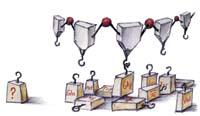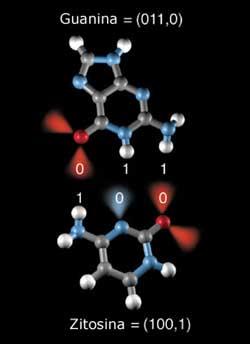Genetic informatics
2010/03/01 Roa Zubia, Guillermo - Elhuyar Zientzia Iturria: Elhuyar aldizkaria

We do not know systems more efficient than life. However, most of our technology is based on lifeless systems. Of course, the reason is that life, to be effective, is based on a very complex system and that the generation of complex technology is very difficult. But maybe we don't. Living systems can do it for us.
It's easy to say, but it's not that easy to get. For example, it is difficult to convince living systems to develop computer components. There are scientists who are doing it and it is difficult. There are good ideas going on. We could make DNA chips, which is the refuge of information in living beings and, therefore, why won't it be the right place to store information?
The first step in achieving this is to control the electrical current within the DNA. But the electrical nature of DNA has not been revealed by scientists. According to a study ten years ago, it is insulating; according to another of the same time, it has the ability to conduct charged molecules; and other researchers proposed that the movement of proteins that read DNA is due to electricity. Everything.
However, most of these studies have focused on the interactions between the bases of DNA, that is, on the electrical interaction that connects both propellers. Few have studied, however, the ability of electrons to move through the axis of the DNA chain; whether they can move as on a cable or not.
The answer is yes, researchers from the Japanese Atomic Energy Agency have concluded. By exciting an electron from a phosphorus atom, it is delocalized into the DNA chain and quickly, a thousand times faster than in the bases. This electron movement can be essential in the mechanism that corrects DNA errors. Man could also take advantage of it, why not?
Data and data
Suppose we control the internal electricity of the DNA molecule and can design transistors and electronic circuits from that molecule as raw material. This allows us to code a lot of 0 and 1. A lot. The cell itself uses it for this purpose. What's more, as there are four bases, you have more than two options, you can code the numbers 0, 1, 2 and 3! Therefore, the electronic use of DNA would allow encoding more data than usual. However, this is not necessarily good.
For example, the increase and decline of memories has generated new problems in computing. The programming itself has changed a lot. Initial programmers did amazing things to save up to a bit of code. The program could not hold a great memory. Therefore, they used very low level languages and had absolute control over each citrin bit that entered and came out in the records at each time (in each processor cycle). They worked with numbers 0 and 1, they thought in binary arithmetic.
But when you don't have to save memory, programming isn't like that. High-level languages are used, meaning that the processor does not understand directly. The process of understanding for the processor generates a repetitive and unrefined code. Programs work, but they have many codes, so to speak, they are left over.
And something similar to genetic material may occur. DNA can also store a lot of information. If used in computer memories, it would be a good place to accumulate a lot of leftover information.
In nature it is so. Throughout evolution, many genetic codes have been accumulating in human chromosomes: some of them were ceded by bacteria and viruses, some due to duplication of genes or errors in cell autofcopy. There are many ways to explain additional genetic information in a genome. All this makes the genome keep a lot of information about it. Gene sequences are interspersed with parts that do not code anything, and that are precisely the parts (introns) that the cell removes before it starts making proteins.
It is true that we do not yet know all the information encoding the genome. Scientists at first believed that parts that did not code proteins did not code information, and all of these parts were called junk DNA. However, in some of these parts it has been found that, for example, there are areas of gene activation. Not all junk DNA is junk.
However, the genome of living beings is not the perfect mathematical system that encodes information. Like software written with high-level language, it doesn't have the most effectiveness it can have. It has repetitive parts and all the information it encodes is not essential to form a living being.
And maybe that's one of the great subjects to learn from genetics and computer science: in a collection of many data, some of them are left over.

Gai honi buruzko eduki gehiago
Elhuyarrek garatutako teknologia





